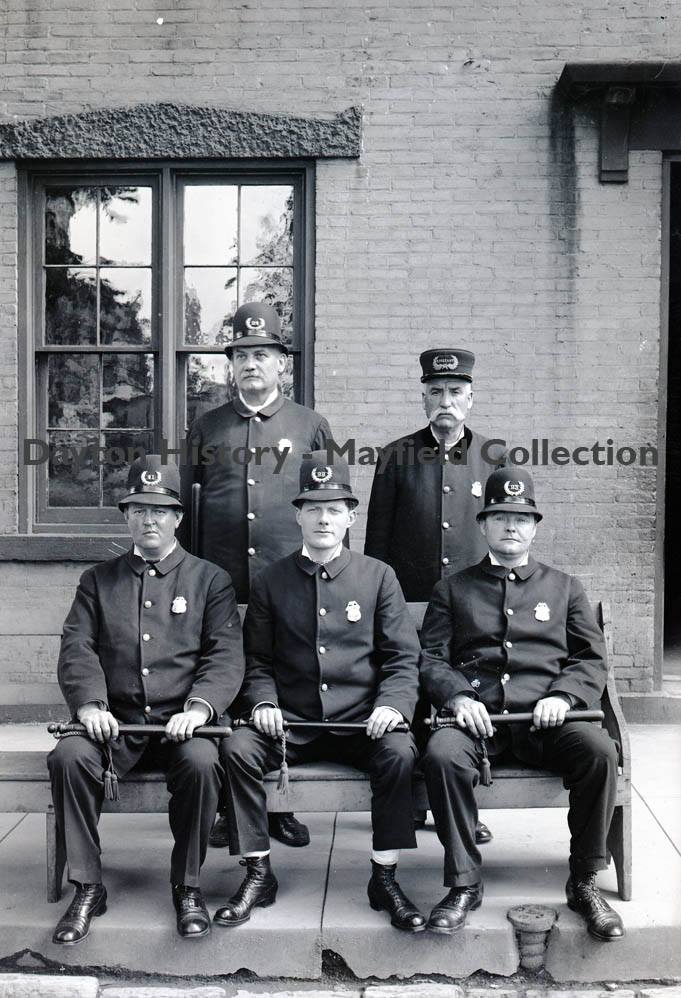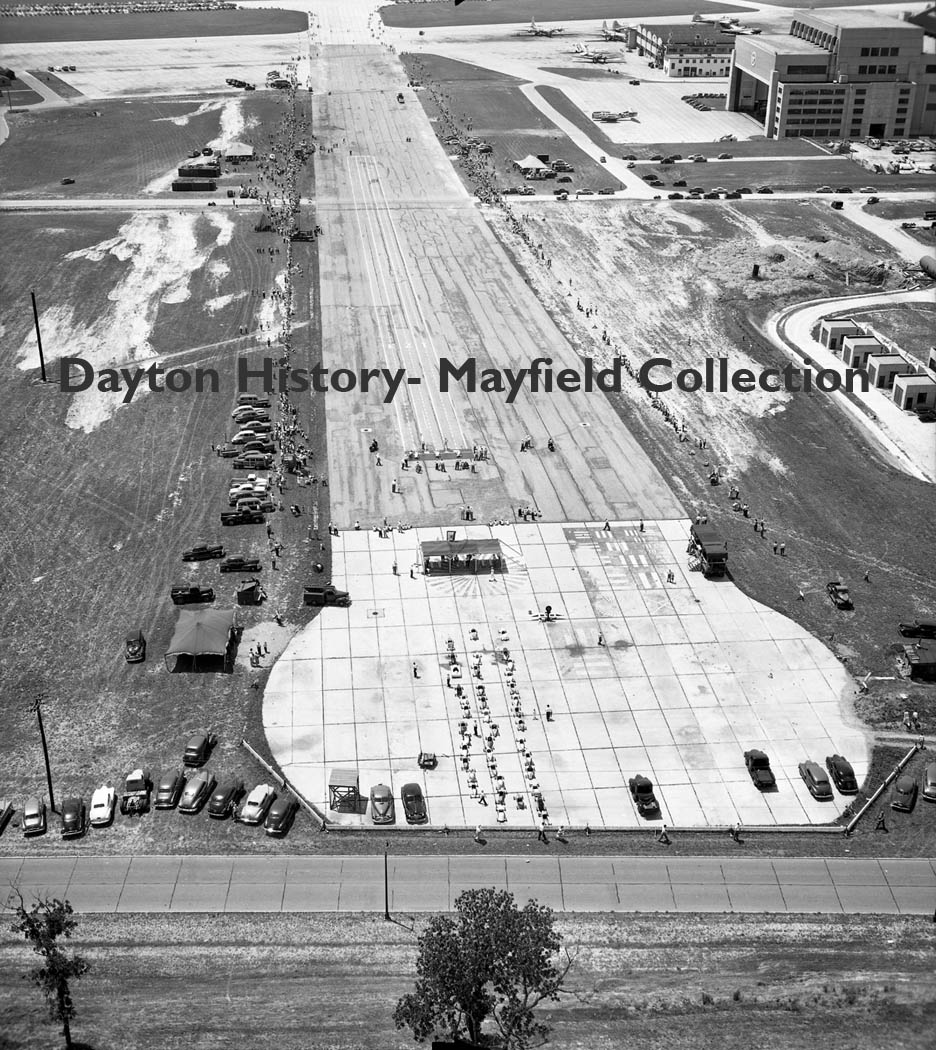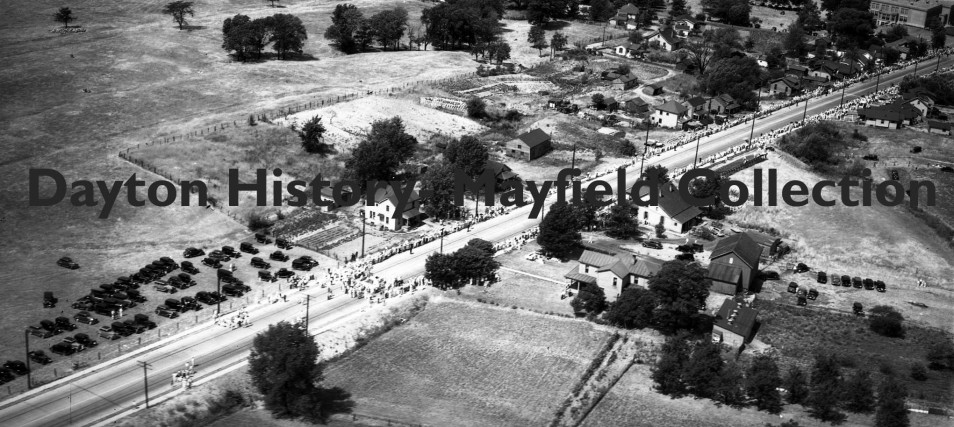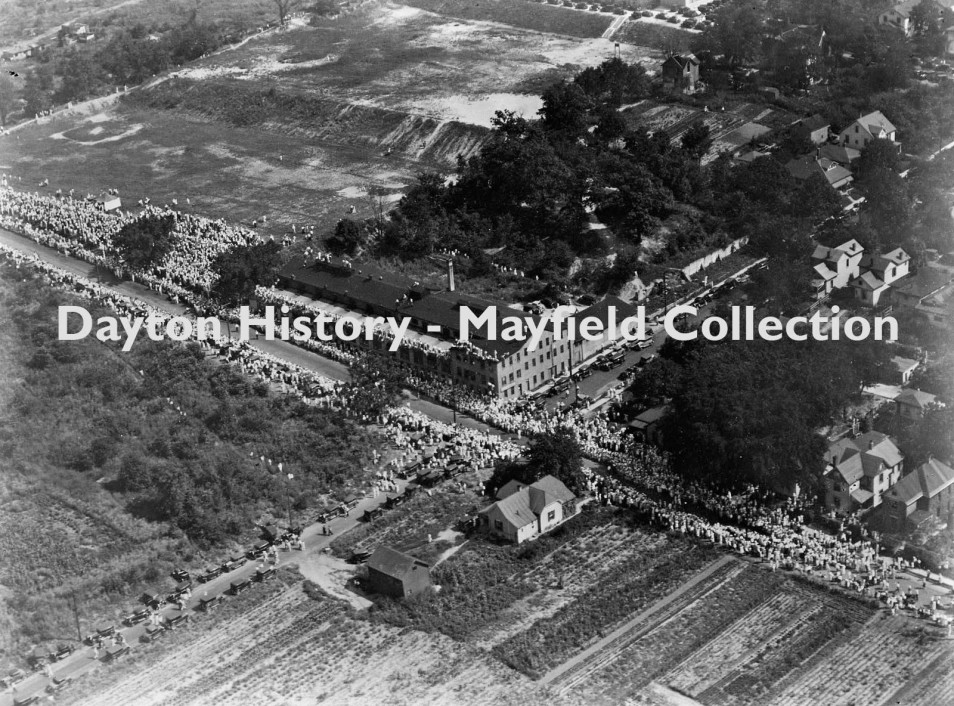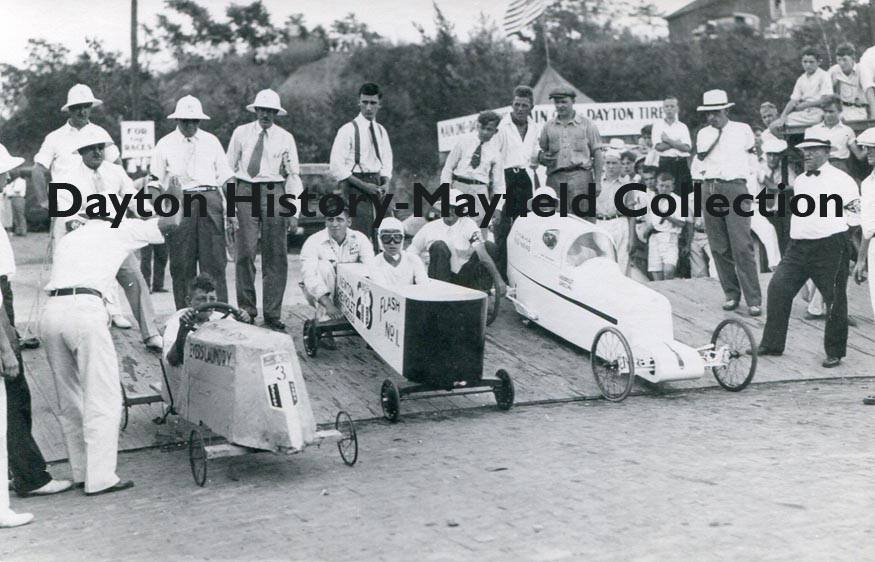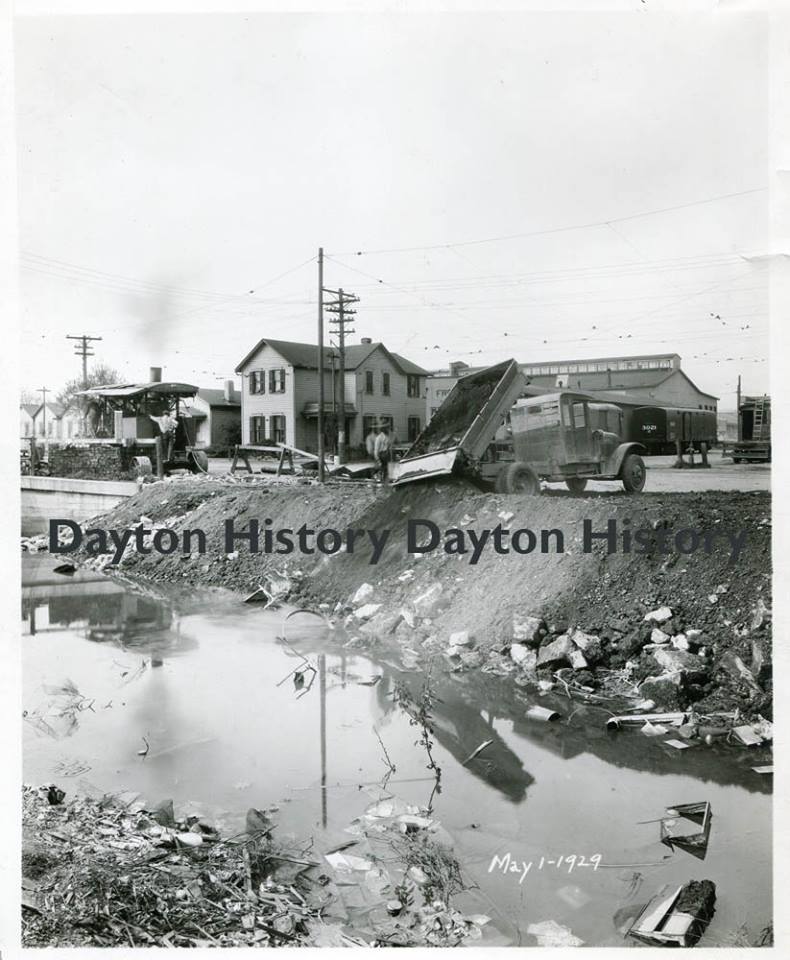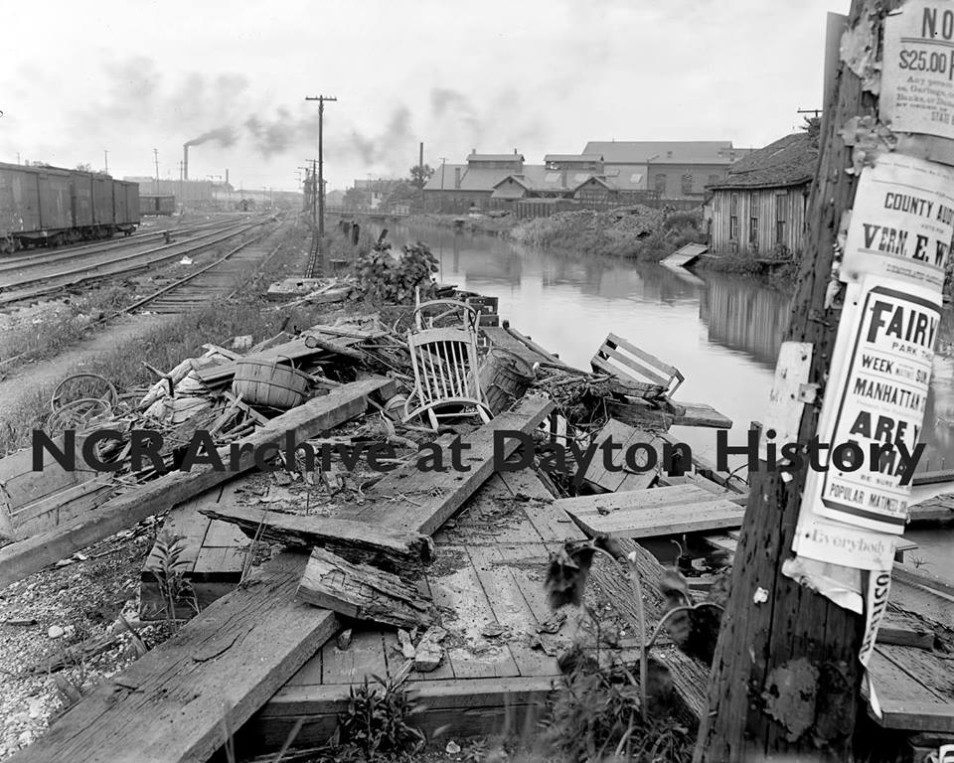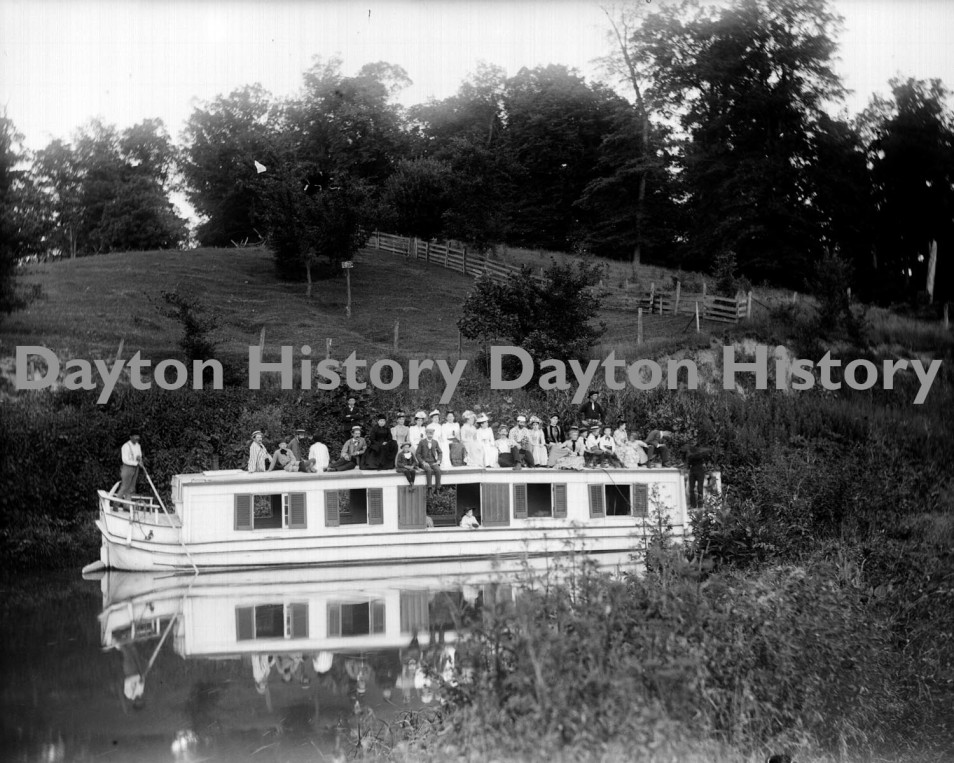ArtiFACT Friday- September 5, 2014
Dayton’s Police Force…
By 1867, Dayton was a full-fledged city that had grown by leaps and bounds. With a population of over 25,000, Dayton was ranked the 45th largest city in the nation. On March 29th of that same year, the state’s legislature granted Dayton the right to organize a police department, as only first-class cities were entitled to do. The newly formed position of ‘Police Patrolmen’ was most often filled by returning Civil War veterans. Prior to that, Dayton’s only means of protection was through its township constable and its own armed citizens. Pictured here are some of Dayton’s finest, circa 1912, sporting their “Peeler” police hats and showing off their wooden clubs, also known as batons. Newly appointed officers at that time were required to buy their own uniforms and firearms, but they were issued hats, clubs, club cords, whistles and badges as standard equipment. This photograph is from the William Preston Mayfield/Marvin Christian Collection at Dayton History.
To see other historical images from our collection, search our Digital Photo Archive.
ArtiFACT Friday- August 29, 2014
Greater Dayton Soap Box Derby Junior Champion poses with his car, c. 1983…
In 1983, the soap box derby celebrated its 50th anniversary in Dayton. Over those first few decades, many changes had occurred to the race. In 1946, the color barrier was broken and by 1971, the race had expanded regulations to allow young girls the opportunity to compete as well. Twenty-five area youngsters completed in two divisions during the 1983 season; all of them vying for the city title on the Area B Acceleration Ramp derby track at Wright-Patterson Air Force Base. In the Junior Division, driving car number 81, 11 year-old Steve Toller won the city junior championship title. Captured in a candid moment, this image shows Toller posing by his winning racer. This photograph is from the Image Collection at Dayton History.
To see other historical images from our collection, search our Digital Photo Archive.
ArtiFACT Friday- August 22, 2014
Dayton’s Soap Box Derby held at Wright-Patterson Air Force Base, c.1949…
Thanks to help from President Franklin D. Roosevelt’s Works Progress Administration, a championship soap box derby track was built in Akron, Ohio, resulting in the move of the All-American Soap Box Derby race from Dayton to northern Ohio. Despite the move, Dayton continued to host races for years, sending its city champs on to Akron for a chance to compete for the national title. With the onset of WWII, the tournament officially suspended activities until the summer of 1946, encouraging everyone to concentrate on the war effort. In 1949, Dayton’s race was held at Wright-Patterson Air Force Base, as can be seen in this aerial image, by photographer William Preston Mayfield. Here, the race track and starting line are clearly visible with a large hangar and several airplanes parked off to the right. This photograph is from the William Preston Mayfield/Marvin Christian Collection at Dayton History.
To see other historical images from our collection, search our Digital Photo Archive.
ArtiFACT Friday- August 15, 2014
View of the Soap Box Derby race track on Germantown Street hill, July 1936…
By 1936, the All-American Soap Box Derby Race had moved north, to Akron, Ohio, and Dayton returned to hosting the Dayton Daily News Soap Box Derby. Daytonians knew they were on to something good as the sport was continuing to spread every year. As a matter of fact, the popularity of the event had even swept across oceans, with contests being held in Puerto Rico and South Africa, just to name a few. Meanwhile, back home, on a Sunday afternoon in July of that year, 170 boys competed, racing their home-made cars down the 900-foot course on Germantown Street hill. An estimated crowd of 15,000 spectators gathered along the track to watch as 13 year-old Eugene Yount sped past the crowd at nearly 30 miles per hour, finishing the course in just 31 seconds. This aerial image, taken by photographer William Preston Mayfield, shows nearly the entire course along Germantown Street hill, with the starting line in the lower left foreground. This photograph is from the William Preston Mayfield/Marvin Christian Collection at Dayton History.
To see other historical images from our collection, search our Digital Photo Archive.
ArtiFACT Friday- August 8, 2014
Spectators line the track of the Soap Box Derby race on Burkhardt Avenue, c. 1934…
In 1933, over 40,000 spectators lined the three-eighths of a mile long track to watch the first ever Soap Box Derby Race. The success of that event spurred Myron Scott, the derby’s creator, to seek out event sponsorship from the Chevrolet Motor Company in Detroit. The following year, in 1934, the newly named All-American Soap Box Derby was a two-day event, with over 100 prizes awarded and more than 350 youngsters from over 33 cities around the country participating. The prizes ranged in value; including everything from small trophies to a motorized Custer car to a four-year college scholarship. This image, captured by photographer William Preston Mayfield, shows just a small part of the massive crowd of spectators who had gathered to watch the race that year along Burkhardt Avenue. Incidentally, this would be the last year the All-American Soap Box Derby would be held in Dayton. This photograph is from the William Preston Mayfield/Marvin Christian Collection at Dayton History.
To see other historical images from our collection, search our Digital Photo Archive.
ArtiFACT Friday- August 1, 2014
Soap Box Derby Race, c. 1934…
Did you know that the soap box derby race, once deemed the “Greatest Amateur Racing Event in the World,” originated here in Dayton, Ohio? One summer day in 1933, Dayton Daily News photographer Myron E. Scott happened upon a small group of boys who were racing home-made wooden cars down Big Hill Road near Oakwood, Ohio. Thinking this would make a great story, Scott decided to organize a race for “anything on four wheels that will coast.” With great fanfare, bands and parades included, the first official soap box derby race, known as ‘The Daily News Soap Box Derby,’ was held on August 19, 1933. More than 300 youngsters gathered together to race that day, most of them driving cars put together from spare parts and other items scrounged from local junk yards. Sixteen year old Oakwood resident, Randall Custer, won that very first derby, driving his three-wheeled coaster nicknamed the “Flashing Yellow Comet.” This image, by photographer William Preston Mayfield, was taken the following year during the 1934 All-American Soap Box Derby race. This photograph is from the William Preston Mayfield/Marvin Christian Collection at Dayton History.
To see other historical images from our collection, search our Digital Photo Archive.
ArtiFACT Friday- July 25, 2014
Filling of the Canal 1929…
After profits began to slip, the State of Ohio decided in 1861 to lease the canals to private interests in hopes they would again become profitable. Unfortunately, this was not to be as the railroad industry had experienced exponential growth within the last two decades, thereby leaving the canals nearly obsolete. Business was so bad in fact that the lessees returned the public works to the state by 1878, in worse condition than before. Public outcry began insisting that the once heralded canals be now disposed of because they had become nothing more than “open sewers” and “detrimental to property values”. Slowly then, the canals were either sold off, mostly to railroads for rights of way, or abandoned all together. For the sections of the canal that were not sold to the railways, they were most often filled in and made into streets, sewers and public highways. Such was the case with part of the Miami and Erie Canal that ran through downtown Dayton, which today is known as Patterson Boulevard. Named for John H. Patterson who had once been a canal toll collector and later in life, an outspoken advocate for the disposal of the outdated canals, Patterson Boulevard runs from Monument Avenue southward towards Kettering. This image shows workman actively filling in what remained of the canal in May of 1929. This week’s photo is from Dayton History’s Image Collection.
To see other historical images from our collection, search our Digital Photo Archive.
ArtiFACT Friday- July 18, 2014
Debris along the Erie Canal…
While the canals in Ohio never achieved the same level of success as the legendary Erie Canal in New York, they did provide the state with great economic advancement, not only through their operation, but also in their construction. The Miami and Erie Canal was constructed over a 20 year period by a workforce of mostly Irish, German and French immigrants for a cost of over $8,000,000. For its time, it was an engineering feat that lifted boats to a height equivalent to that of a 50-story building. The summit of the canal at Loramie was 512 feet above the level of the Ohio River, which meant that the canal boats were essentially traveling uphill, for a distance of 100 miles before starting downward again towards Lake Erie. Canal operation peaked in 1851, but its influenced waned in the following years due mostly to the growth and spread of the railroads. By 1856, expenditures had exceeded revenues for the first time for the Miami and Erie Canal. By 1877, operations were officially abandoned though some measure of use continued through the early 1900s. With canal traffic greatly diminished and in some places completely abandoned, there were no funds for the much needed repairs and upkeep so, the once useful canals, became public dumping grounds, full of trash and refuse; becoming a breeding ground for all manner of pest and disease. This week’s photo is from the NCR Archive at Dayton History.
To see other historical images from our collection, search our Digital Photo Archive.
ArtiFACT Friday- July 11, 2014
Canals and their Commercial and Social Influence…
Ohio farmers and manufacturers were producing goods in abundance and much of the East Coast was in want of those very products. Unfortunately, transportation costs had skyrocketed because over land transport was painfully slow and treacherous and river transport had become unreliable as dams and milling operations built along waterways had caused severe fluctuations in the flow of water. A canal system would provide the state with the necessary means to move people and goods in a more efficient and cost effective manner so construction began on the Miami and Erie Canal in 1825. Once completed, the canal was over 248 miles in length and had 19 aqueducts, 106 locks, and three large reservoirs that had been built to feed the waterway in times of low water. But the canal did more than just provide transport for goods, as it was also a means for social exchange and recreation. In the summer months, groups and organizations would hire canal boats for social outings and picnics. A not uncommon sight along the way include seeing folks taking a dip in the cool canal waters on a hot summers day or relaxing under a shade tree with their favorite fishing pole by their side. In the winter, when the canal froze over, many an adventurer could be found ice skating back and forth on the smooth, frozen surface. This week’s photo is from the Albert Kern Collection in Dayton History’s Image Collection.
To see other historical images from our collection, search our Digital Photo Archive.
ArtiFACT Friday- July 4, 2014
A New Era Begins…
On this day, one hundred and ninety-two years ago, during 4th of July festivities in Newark, Ohio, Governor DeWitt Clinton of New York and Governor Jeremiah Morrow of Ohio dug the first spadesful of dirt, officially beginning work on the Ohio and Erie Canal. Seventeen days later, in Middletown, Ohio, Governor Clinton and several other notable individuals held a second ground-breaking ceremony, this time for the Miami and Erie Canal. Thus, the age of the canals had begun in earnest, in the great State of Ohio. The idea of connecting the Great Lakes and the mighty rivers of the Ohio and the Mississippi was not a new one. It was Thomas Jefferson, who, in 1786-87, was first to make a definite proposal for connecting these by means of a canal going through the state. The canals had a profound effect in Ohio, having increased the potential for economic development prior to the Civil War; thereby transforming what had been a somewhat isolated wilderness into a powerful state, both in terms of population and wealth. Such was the case for Dayton and the rest of Montgomery County as well, with the Miami and Erie Canal stretching from Toledo and Lake Erie down to Cincinnati and the Ohio River. A new era of prosperity and growth had begun as goods, information and people were now able to travel great distances more efficiently and cost-effectively than over land. Pictured here is a section of the canal, lined with businesses in downtown Dayton. The image is from the Albert Kern Collection at Dayton History.
To see other historical images from our collection, search our Digital Photo Archive.




